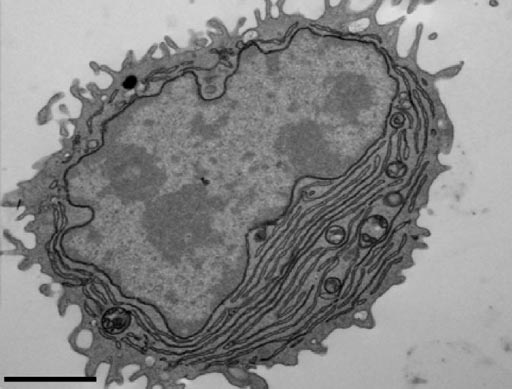Novel In Vitro Method May Revolutionize Antibody Production
By LabMedica International staff writers
Posted on 10 Aug 2017
A novel method for boosting the ability of a vaccine to stimulate production of antibodies is based on the in vitro stimulation of B-cells with nanoparticles conjugated to both GpG and antigen.Posted on 10 Aug 2017
Antigen-specific B-cell activation is a key step in the initiation of immune responses. The in vitro activation of B-cells in an antigen-dependent manner is difficult to achieve, because wide haplotype variations necessitates the use of unique T-cells specific to a particular antigen to activate the B-cells. To overcome this limitation, investigators at the Francis Crick Institute (London, United Kingdom) and colleagues in the United States developed a novel, in vitro strategy to stimulate human B-cells with streptavidin nanoparticles conjugated to both GpG and antigen.

Image: An electron microscopy image showing an antibody-secreting plasma cell generated using antigen- and CpG-coated nanoparticles (Photo courtesy of Sanjuan Nandin et al., 2017).
CpG oligodeoxynucleotides (or CpG ODN) are short single-stranded synthetic DNA molecules that contain a cytosine triphosphate deoxynucleotide (C) followed by a guanine triphosphate deoxynucleotide (G). The (p) refers to the phosphodiester link between consecutive nucleotides. When these CpG motifs are unmethylated, they act as immunostimulants. The CpG signature is recognized by the pattern recognition receptor (PRR) Toll-Like Receptor 9 (TLR9), which is constitutively expressed only in B-cells and plasmacytoid dendritic cells (pDCs) in humans and other higher primates.
The investigators reported in the July 24, 2017, online edition of The Journal of Experimental Medicine that the stimulatory effect achieved by this technique induced antigen-specific B-cell proliferation, differentiation of B-cells into plasma cells, and robust antibody secretion after a few days of culture. The investigators validated this strategy using cells from healthy donors to retrieve human antibodies against tetanus toxoid and influenza hemagglutinin (HA) from H1N1 and newly emergent subtypes such as H5N1 and H7N9.
Anti-HA antibodies were cross-reactive against multiple subtypes, and some showed neutralizing activity. Although these antibodies may have arisen as a result of previous influenza infection, the investigators also obtained gp120-reactive antibodies from non–HIV-infected donors, indicating that they could generate antibodies without prior antigenic exposure.
"Specifically, it should allow the production of these antibodies within a shorter time frame in vitro and without the need for vaccination or blood/serum donation from recently infected or vaccinated individuals," said senior author Dr. Facundo Batista, formerly at the Francis Crick Institute and now at the Ragon Institute (Boston, MA, USA). "In addition, our method offers the potential to accelerate the development of new vaccines by allowing the efficient evaluation of candidate target antigens."
Related Links:
Francis Crick Institute
Ragon Institute













